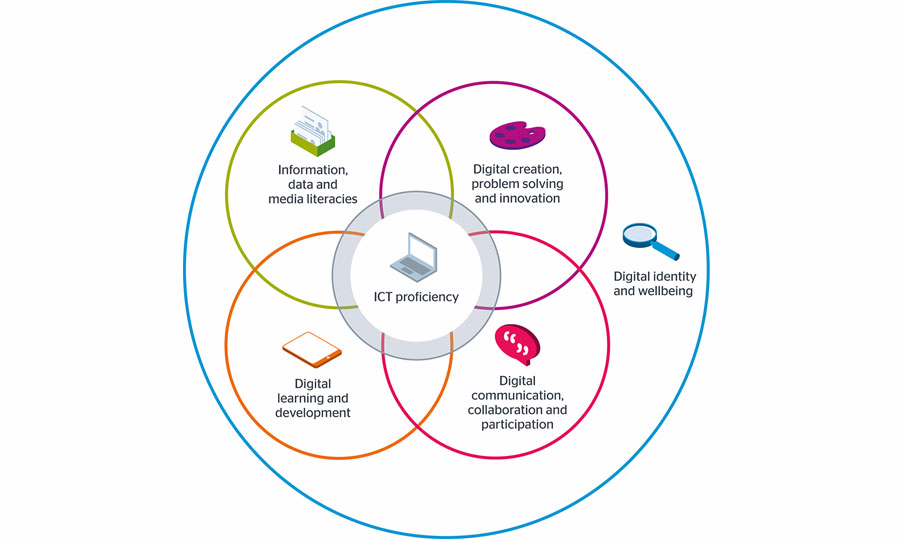Digital Identity Management and Digital Wellbeing Unpacked

If you have found this blog, you’ve either used the Jisc Digital Discovery Tool or you’re wondering what it is about. If you don’t already know, the Digital Discovery Tool is a self-assessment tool developed by Jisc for staff and students in Further and Higher Education to help them evaluate their standing (and potential need for development) in different digital capabilities. One key element of these digital capabilities is the area of Digital Identity Management and Digital Wellbeing and this post will explore what these concepts mean, why we need to be aware of them and how we can start to act on the results of the Digital Discovery Tool.
The thinking behind the tool itself
University students and staff need to be equipped by their institutions with the digital skills required not only to live, learn and work in a digital society but to thrive in it. The majority of us are accustomed to using technology in our daily lives but it has become so ubiquitous that it is useful to pause and reflect on our digital capabilities. It is important to consider the various and specific aspects of digital capabilities that make up technological proficiency, to recognise that we may have strengths in some areas and room for improvement in others.
What is equally important and probable is coming across digital capabilities that we didn’t even know existed.
I expect that this is the case for many when it comes to Digital Identity Management and Digital Wellbeing.

Digital Identity Management and Digital Wellbeing Defined
In the downloadable individual report you will receive on completing the Discovery Tool, Jisc give explanations of each of the capabilities and steps to improve them.
Digital Identity Management is defined as:
“[…] how you develop and project a digital identity – or several identities – and how you manage your digital reputation. Most of us have identities distributed across a range of platforms and media. Do you keep these separate, or aim to make them work together? How do you manage assets such as profiles, records of achievement, contacts and networks to achieve your personal goals?” (Jisc digital capability report: 2019)
(Jisc digital capability report: 2019)
I would imagine that most of us, when we are posting on Facebook, Twitter or Instagram, aren’t aware that we are developing and projecting digital identities. We are aware that what we post is seen and reacted to, but do we consider how this shapes our identity or an identity of ours? And if we aren’t even aware we are doing this…how can we be expected to manage it?
To me, Digital Identity Management is all about awareness. It is being aware of what we are already doing on social media, how accessible and far-reaching that is and deciding what we are happy to broadcast and what we would prefer to keep private.
Digital Wellbeing is defined as:
“[…] how you look after your personal health, safety, relationships and work-life balance in digital settings. Do you use your data and devices in pursuit of positive personal goals (e.g. health and fitness)? Do you participate in online activities and networks that make you feel good? We all need help sometimes to manage digital stress, workload and distraction. We could all learn to use digital tools with more concern for each other and for the wider world.” (Jisc digital capability report: 2019)
(Jisc digital capability report: 2019)
This is a fairly new term both within and beyond education. ‘Wellbeing’ itself is a difficult term to pin down and it will mean different things to different people. However, identifying a capability such as ‘Digital Wellbeing’ recognises that living and working with technologies has an effect on our lives. Much like understanding that everyone has mental health and needs to keep their mind healthy, understanding that we have the capability to look after our digital wellbeing is the first step enabling us to do so.

The definition from Jisc’s framework was composed by Helen Beetham, who explains in a blog post her thinking on situating Digital Wellbeing as a capability:
“It was challenging to insert wellbeing into a framework of individual capabilities, especially as I don’t think being well is only or mainly an individual responsibility. The design of learning systems, the contents of digital curricula, the distribution of digital know-how, the business models of digital development, the globalisation of digital labour… these are issues with profound impact on our capacity to thrive, over which no individual has control. But I think it’s useful, and potentially radical, to suggest that digital capability includes self-care, and that self-care requires a critical awareness of how digital technologies act on us and sometimes against us, as well as allowing us to pursue our personal and collective aspirations in new ways.”
(design-4-learning.blogspot.com: 2016)
Again, awareness is important here. This time it is a critical awareness that is necessary to recognise how digital technologies impact us and to then implement ways to cope with that which is within our control. As Beetham says, it is not an individual responsibility and individual capability needs to be supported by institutions and workplaces.
That’s why we have developed resources to guide students and staff on how they can enhance both their Digital Identity Management and Digital Wellbeing, you’ll see more on this soon.
A good place to start
Digital Identity and Wellbeing are not the only digital capabilities defined by Jisc. Below is a diagram of the six key elements of the digital capability framework and how they relate to each other.
You’ll see that Digital Identity and Wellbeing form a key element which encompasses all others.

The capabilities of Digital Identity and Wellbeing harness and support all others. If you can protect yourself online, in regards to privacy, data, identity, wellbeing and mental health, then you have the essential foundations on which you can begin to build and develop your other capabilities. This makes Digital Identity and Wellbeing a very good place to start when it comes to digital capabilities, as they allow you to thrive in all other aspects of digital use.
So once you’ve completed the Discovery Tool, have a look at the video we have developed below to find out how you can enhance your Digital Identity and Wellbeing and kick start your journey with digital capabilities.